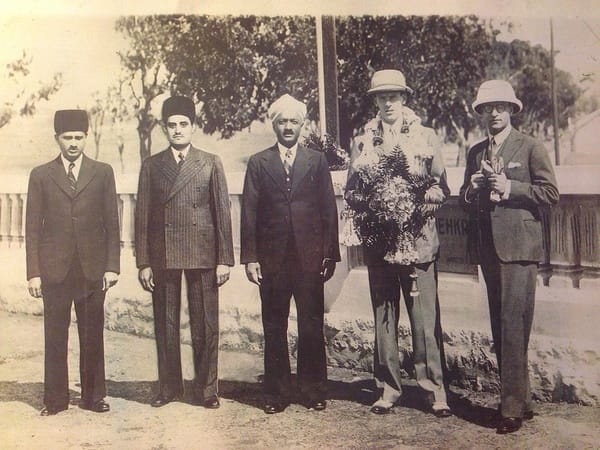
How well do you know Namma Bengaluru? Let me start with a question. Who was the person that personally financed the levelling of a road with the intention of alleviating the pain of bullocks dragging heavy cartloads up a steep slope?
If you don’t know, this man was Enayathullah Mekhri, who took notice of the sufferings of bullocks, and decided to act on it. Despite being offered compensation by the king of Mysore for his selfless act, Mekhri refused it. Such was his nature. Therefore, in honour of this gracious act and his willingness to help society at large, the junction at this road came to be known as Mekhri Circle.

An old picture of Enayathullah Mekhri (second from left). Pic courtesy: Abid Mekhri
In Bangalore, as in several other cities across the world, there are a plethora of roads/ parks/ circles, named after people who have contributed to society in various unique ways. While the names of the individuals remain in our minds because of these public spaces, their original contributions to society are mostly forgotten.
City Idols is an initiative that is working to revive the legacies of these people, by researching, collating and disseminating research about their stories, lives and contributions. The main objective of the programme is to identify local role models who can inspire youth to contribute in different ways to improve their communities.
The birth of City Idols
Whenever we used to travel in Bangalore as a family, my mother would ask me to read Kannada sign boards for reading practice. Many of these sign boards that I read ended up being those naming roads and parks. And, interestingly many of these roads and parks were named after people.
Having received unsatisfactory responses from my parents as to who these people were, I looked up the Internet. To my astonishment, I found that in fact, very little content about such people was available even on the Internet. Of course there was information on D.V. Gundappa and Kengal Hanumantaiah, but who were Omer Sheriff and Govindappa? Curiosity piqued, I started on this journey that became City Idols.
Why research street names?
The process of researching and documenting stories about the lives and contributions of people after whom our roads and parks are named presents an exciting learning opportunity for high school/college students. It encourages students to appreciate and take pride in the abundant local history of “Namma Bengaluru”.
It also provides an occasion to learn about conducting research through alternative mediums even in the age of the Internet, such as visiting libraries, archives, searching books etc.
One other very interesting means for conducting research is Oral Research. As part of Oral Research, students can visit the road itself, and engage with some of the elderly residents and old shop owners to discover the story behind its naming. One can also meet the owners of old bookstores and librarians at old city libraries. These people are usually powerful storehouses of local history!
How you can get involved
Bengaluru has around 300 roads named after people. The students of Sri Kumaran Children’s Home and Christ University have researched some of these roads. It is now for all of us to augment and add to the volume of entries on the people after whom these are named.
Over the next couple of months, we are trying to put our best foot forward for the “City Idols Century Countdown”, at the end of which we hope to reach the landmark of a hundred research entries. With this goal in mind, we are reaching out to various schools and colleges to see if students would be interested to engage in similar research and contribute to City Idols. In the long run, we wish for City Idols to spread to more and more cities across India, and ideally maintain itself as a self-sustainable concept.
For this, City Idols would need the support and help of all Bengalureans. The City Idols team sincerely appeals to all citizens to join them and collectively enrich their heritage. For a start, each of you can research a road in your own neighbourhood that has been named after a person.
It’s not difficult at all and the joy that you will experience as you rediscover forgotten histories is palpable. But do please share your findings with us on the City Idols website! You can also read more at http://cityidols.blogspot.in/
Sri. Raghav Madhukar’s interest in knowing more about people who have contributed to Society in various ways requires encouragement. This interest of student of class ‘X’ is to be appreciated and many more students may be encouraged to k now about heritage value.
The political parties in power are not interested in the heritage value and renamed some of the roads. Cunningham Road is now renamed as Sampangirama Swamy Temple Road. The effort pf Cunningham during Britishers rule forming an important wide road in the central area was forgotten. Infantr Road in the central area is another road renamed as Bhagwan Mahaveer Jain Road. Renaming of this was done when BJP was in power in Karnataka. Jain Sangh is located on Infantry Road, opposite Hindu newspaper building, to attract votes of marvadi people for election.
The name of Shivajinagar opposite Gosha Hospital is named as Swamy Shivananda Puram.
There are several other instances of changing names of roads of heritage value.
My opinion is to give such names for new roads or BDA extensions/roads not so far named and not roads with heritage value.
___________
– Dr. A. S. Kodanda Pani,
Urban Planner & Civic Analyst